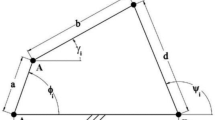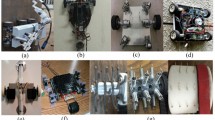Abstract
The control of a robot is optimized to improve its energy efficiency and stability in a geometrically complex environment. For this purpose, analysis is performed on the dynamic modeling of a multi-body robot that can transition its position on corners where horizontal ground and a vertical wall intersect. The robot consists of three bodies that can be attached to the wall by permanent magnetic adhesion and connected by links with two types of compliant joints: a passive type with a torsion spring and an active type with a torque-controlled motor. A dynamics model is derived using the Lagrangian formulation, and investigated in the case of internal corner. Difficulties in the analysis of dynamics for this wall-climbing robot came from how to manage external forces. The external forces acting on the wall-climbing robot result from the wall and the magnets, which change the acting points of the forces. Experiments were conducted to determine the magnetic force with respect to distance. Simulation was then performed to verify the dynamic model. The obtained dynamic model can offer a competent tool for the design and control of the autonomous wall-climbing robot, which can be used for the inspection of heavy-industry buildings, and oil tanks where the geometrically horizontal surface and the vertical wall intersect.
Similar content being viewed by others
References
Z. Xu and P. Ma, A wall-climbing robot for labelling scale of oil tank’s volume, Robotica, 20 (2) (2002) 209–212.
L. P. Kalra, J. Guf and M. Meng, A wall climbing robot for oil tank inspection, Proc.of the IEEE International Conference on Robotics and Biomimetics (2006) 1523–1528.
H. Schempf, B. Chemel and N. Everett, Neptune: above-ground storage tank inspection robot system, Robotics and Automation Magazine, 2 (2) (1995) 9–15.
J. Sanchez, F. Vazquez and E. Paz, Machine vision guidance system for a modular climbing robot used in shipbuilding, Climbing and Walking Robots, (2006) 893–900.
P. Gonzalez de Santos, M. Armada and M. A. Jimenez, Ship building with rower, IEEE Robotics and Automation Magazine, 7 (4) (2000) 35–43.
G. Lee, K. Seo, S. Lee, S. Park, H. Kim, J. Kim and T. Seo, Compliant track-wheeled climbing robot with transitioning ability and high-payload capacity, proc. of the 2011 IEEE International Conference on Robotics and Biomimetics, Phuket (Thailand) (2011) 2020–2024.
F. Xu, L. Wang, X. Wang and G. Jiang, Dynamic performance of a cable with an inspection robot — analysis, simulation, and experiments, J. of Mechanical Science and Technology, 27 (5) (2013) 1479–1492.
J. Krahn, Y. Liu, A. Sadeghi and C. Menon, A tailless timing belt climbing platform utilizing dry adhesives with mushroom caps, Smart Mater. Struct., 20 (11) (2011) 115021.
H. Kim, H. Yang, K. Lee, K. Seo, D. Chang and J. Kim, Development of a wall-climbing robot using a tracked wheel mechanism, J. of Mechanical Science and Technology, 22 (8) (2008) 1490–1498.
T. Seo and M. Sitti, Tank-like module-based climbing robot using passive compliant joints, IEEE/ASME Transaction on Mechatronics, 18 (1) (2013) 397–408.
G. Lee, G. Wu, J. Kim and T. Seo, High-payload climbing and transitioning by compliant locomotion with magnetic adhesion, Robotics and Autonomous Systems, 60 (10) (2012) 1308–1316.
B. Chu, K. Jung, C. Han and C. Hong, A survey of climbing robots: locomotion and adhesion, International journal of precision engineering and manufacturing, 11 (4) (2010) 633–647.
S. Hirose, H. Tsutsumitake, R. Toyama and K. Kobayashi, Disk rover: A wall-climbing robot using permanent magnet disks, Proc. IEEE/RSJ Int. Conf. on Intelligent Robots and Systems (1992) 2074–2079.
B. L. Luk, A. A. Collie and J. Billingsley, Robug II: An intelligent wall climbing robot, In: Proc. IEEE International Conference on Robotics and Automation, CA. (1991) 2342–2347.
T. Akinfiev, M. Armada, M. Prieto and M. Uquillas, “Concerning a technique for increasing stability of climbing robots, Journal of Intelligent and Robotic Systems, 27 (1) (2000) 195–209.
L. P. Kalra, W. Shen and J. Gu, A wall climbing robotic system for non-destructive inspection of above ground tanks, Canadian Conference on Electrical and Computer Engineering, Ottawa (Canada) (2006) 402–405.
Z. Liguo, T. Shizhong, F. Guizeng and L. Xi, Design on a wall-climbing robot for test of large-capacity tank volume, 2010 International Conference on Digital Manufacturing and Automation, Changsha(china) (2010) 510–513.
X. Wang, Z. Yi, Y. Gong and Z. Wang, Optimum dynamic modeling of a wall climbing robot for ship rust removal, Proc. of the conference on Intelligent Robotics and Applications (2009) 623–631.
P. Schoeneich, F. Rochat, O. T-D. Nguyen, R. Moser and F. Mondada, TRIPILLAR: a miniature magnetic caterpillar climbing robot with plane transition ability, Robotica, 29 (7) (2011) 1075–1081.
Y. Zhang, T. Dodd, K. Atallah and I. Lyne, Design and optimization of magnetic wheel for wall and ceiling, Climbing Robot, Proc. of the 2010 IEEE International Conference on Mechatronics and Automation, Xi’an (China) (2010) 1393–1398.
S. A. A. Moosavian, K. Alipour and Y. Bahramzadeh, Dynamics modeling and tip-over stability of suspended wheeled mobile robots with multiple arms, Proc. of the 2007 IEEE/RSJ International Conference on Intelligent Robots and Systems, San Diego (USA) (2007) 1210–1215.
Z. Zhu, J. Li, Z. Gan and H. Zhang, Kinematic and dynamic modelling for real-time control of tau parallel robot, Mech. Mach. Theory, 40 (9) (2005) 1051–1067.
L. Makarem, A. Akbarimajd and M. Ahmadabadi, Dynamic manipulation of active objects: modeling and optimization, IEEE/ASME International Conference on Advanced Intelligent Mechatronics, Singapore (2009) 1400–1405.
R. M. Murray, Z. Li and S. S. Sastry, A mathematical introduction to robotic manipulation, CRC Press (1994) 54–64.
Y. Li, F. Xi, A. D. Finistauri and K. Behdinan, Dynamic modeling and analysis of a circular track-guided tripod, ASME J. Comput. Nonlinear Dynam, 5 (1) (2010) 011005.
Y. Li, F. Xi and K. Behdinan, Dynamic modeling and simulation of percussive impact riveting for robotic automation, ASME J. Comput. Nonlinear Dynam, 5 (2) (2010). 021011.
Author information
Authors and Affiliations
Corresponding authors
Additional information
Recommended by Associate Editor Hyungpil Moon
Sungmin Nam received the B.S. degree in the school of mechanical and aerospace engineering from Seoul National University, Seoul, Korea, in 2013. He is currently pursuing a Ph.D. in the school of mechanical engineering from Stanford University, CA, USA. His research interests include modeling and control of wall climbing robots.
Jongkyun Oh received the B.S. degree in the school of mechanical engineering from Chungnam National University, Daejeon, Korea, in 2011. He is currently pursuing a M.S. degree in the school of mechanical and aerospace engineering from Seoul National University, Seoul, Korea. His research interests include control and path planning ofwall climbing robots.
Giuk Lee received the B.S. and Ph.D. degrees in the school of mechanical and aerospace engineering from Seoul National University (SNU), Seoul, Korea, in 2010 and 2014, respectively. He is a post-doctor in SNU from 2014. His research interests include redundant parallel mechanism and wall climbing robots.
Jongwon Kim is a Professor in the School of Mechanical and Aerospace Engineering, Seoul National University, Korea. He received the B.S. degree in Mechanical Engineering from Seoul National University in 1978, and the M.S. degree in Mechanical and Aerospace Engineering from KAIST, Korea, in 1980. He received the Ph.D. in Mechanical Engineering from the University of Wisconsin-Madison, USA, in 1987. He worked with Daewoo Heavy Industry & Machinery, Korea, from 1980 to 1984. From 1987 to 1989, he was Director of the Central R&D Division at Daewoo Heavy Industry & Machinery. From 1989 to 1993, he was a Researcher at the Automation and Systems Research Institute at Seoul National University. His research interests include parallel mechanisms, Taguchi methodology, and field robots.
TaeWon Seo is an Assistant Professor in the School of Mechanical Engineering, Yeung-nam University, Gyeongsan, Korea. He received the Ph.D. in Mechanical Engineering, Seoul National University, in 2008. He was a Post-Doctoral Researcher at the Nanorobotics Laboratory, Carnegie Mellon University, in 2009. His research interests include creative robotic platform design, control, optimization, and motion planning.
Rights and permissions
About this article
Cite this article
Nam, S., Oh, J., Lee, G. et al. Dynamic analysis during internal transition of a compliant multi-body climbing robot with magnetic adhesion. J Mech Sci Technol 28, 5175–5187 (2014). https://doi.org/10.1007/s12206-014-1141-z
Received:
Revised:
Accepted:
Published:
Issue Date:
DOI: https://doi.org/10.1007/s12206-014-1141-z




